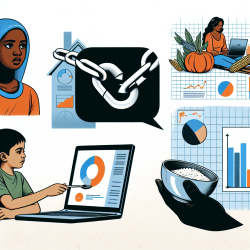Introduction
As practitioners in the field of speech-language pathology, it is crucial to stay informed about various factors that can impact the well-being and development of children. One such factor is food insecurity, which can have significant implications on a child's cognitive and emotional development. The research article titled Invariance of the Household Food Insecurity Access Scale Across Different Groups of Adolescents and Young Adults provides valuable insights into how food insecurity is measured and interpreted across different youth groups. This blog will discuss how practitioners can leverage the findings from this research to improve their practice and encourage further research.
Understanding Food Insecurity and Its Measurement
Food insecurity is defined as the lack of access to adequate food due to financial constraints. It is commonly measured using scales such as the Household Food Insecurity Access Scale (HFIAS). The research by Masa and Sharma (2021) examines whether the HFIAS is invariant across different groups of adolescents and young adults in Ghana and South Africa. Invariance testing ensures that the scale measures the same construct across different groups, allowing for meaningful comparisons.
Key Findings
The study found that the HFIAS had configural, metric, and scalar invariance across various youth groups. This means that the scale measures food insecurity consistently across different groups, including gender, age, and socioeconomic status. Here are some key findings:
- Configural Invariance: The 1-factor model of the HFIAS applies to different youth groups, indicating that the scale's structure is consistent.
- Metric Invariance: The individual items on the HFIAS have similar weights and are equally relevant to the construct of food insecurity across different groups.
- Scalar Invariance: Differences in HFIAS scores reflect true differences in food insecurity levels across different groups.
Implications for Practitioners
Understanding that the HFIAS is a reliable measure across different youth groups allows practitioners to confidently use this scale in their assessments. Here are some ways to implement these findings in practice:
- Holistic Assessments: Incorporate food insecurity assessments into your initial evaluations to understand the broader context of a child's environment.
- Targeted Interventions: Use the data to develop targeted interventions that address not only speech and language issues but also underlying factors like food insecurity.
- Collaborative Efforts: Work with other professionals, such as social workers and nutritionists, to create comprehensive care plans that address all aspects of a child's well-being.
Encouraging Further Research
While the findings of this study are significant, there is always room for further research. Practitioners are encouraged to explore additional factors that may impact food insecurity and its effects on children. Future research could focus on:
- Longitudinal studies to understand the long-term effects of food insecurity on speech and language development.
- Cross-cultural studies to validate the HFIAS in different settings and populations.
- Interventional studies to evaluate the effectiveness of integrated care plans that address both food insecurity and speech-language issues.
Conclusion
The research on the invariance of the HFIAS provides valuable insights that can enhance the practice of speech-language pathology. By incorporating these findings into assessments and interventions, practitioners can create more comprehensive and effective care plans for children. To read the original research paper, please follow this link: Invariance of the Household Food Insecurity Access Scale Across Different Groups of Adolescents and Young Adults.










